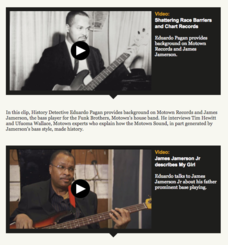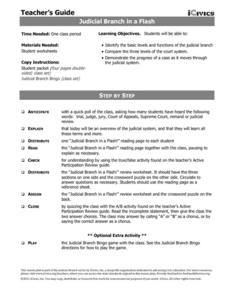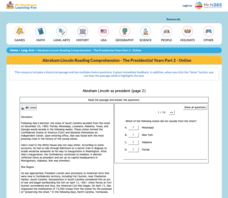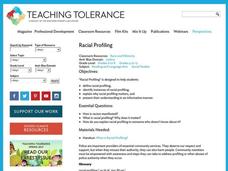Curated OER
Upon the Clouds of Equality: King Day
Students learn about equality, justice and fairness. In this equality instructional activity, students experience what it feels like to be treated unequally. Students examine Martin Luther King, Jr.'s dream of equality and his actions...
PBS
The Sixties: Hitsville USA
James Jamerson. You probably heard him but may not have heard of him. But fans of Motown Records will certainly recognize his contributions to the sound that desegregated popular music during the 1960s. Challenge young history detectives...
Center for Instruction, Technology, & Innovation
Did African American Lives Improve After Slavery?
The Civil War made slavery illegal, but all ex-slaves were not totally free. Scholars visit eight different classroom stations to uncover life during the Reconstruction Era in America. Groups discover items such as Black Codes, 13th,...
Roy Rosenzweig Center for History and New Media
Rosa Parks and the Montgomery Bus Boycott
Participants examine two documents related to Rosa Parks and the bus boycott, sources that challenge some of the commonly held preconceptions about Rosa Parks. They then respond to discussion questions to reinforce understanding and...
Reed Novel Studies
The Red Badge of Courage: Novel Study
A novel study guide for Stephen Crane's The Red Badge of Courage follows Henry through his encounter with war Activities include asking readers to complete sentences with vocabulary words, write using personification, and answer...
Curated OER
Criminal or Hero
Young scholars investigate slavery in America circa the American Revolution. They will examine point- of view and perspective as they research a variety of informational resources. While this is designed to be used with the PBS video...
C-SPAN
Presidential Veto and Congressional Override
One of the key powers of the executive branch is the president's ability to pass or veto legislation proposed by Congress. Congress, the legislative branch, on the other hand, can override a president's veto. Five film clips show how the...
Curated OER
Constitutional Amendments And Gay Marriage
Upper graders critically examine the history and process of amending the U.S. Constitution in light of the current issue facing the courts on legalizing gay marriage. They read a variety of articles, watch news clips, and develop a...
Curated OER
Constitutional Amendments and Gay Marriage
High schoolers study the legal battles involving same-sex marriage. They examine primary sources and a video regarding the 14th amendment and its implications for gay marriage. They analyze a report of a California case that was sent to...
iCivics
Judicial Branch in a Flash
What is the difference between the federal court and state court systems? What about criminal versus civil cases? Check out this resource that will offer your class members a general and effective overview of the judicial branch in the...
Novelinks
Nightjohn: List-Group-Label Strategy
Encourage readers of Nightjohn, Gary Paulsen's young adult novel about slavery set shortly before the Civil War, to develop their categorization and organizational skills with a strategy that asks them to list all the words they can...
Mr. Nussbaum
Abraham Lincoln Reading Comprehension—The Presidential Years (Part 2)
How does a president save a country from itself? Readers learn how the Civil War began and how Lincoln managed it with a reading comprehension passage. They then demonstrate their understanding with multiple choice questions that...
Teaching Tolerance
Racial Profiling
Racial Profiling. Class members chart what they know and what they want to know about this hot-button topic.
Curated OER
A Hero Betrayed: The Presidency of Ulysses S. Grant
Students analyze the career of Ulysses S. Grant. In this Grant presidency instructional activity, students listen to their instructor present a lecture regarding the details of Grant's presidency. Students respond to discussion questions...
Curated OER
Court Documents Related to Martin Luther King, Jr., and Memphis Sanitation Workers
Young scholars read about the civil rights movement in their textbooks. They engage in a whole-class discussion of how nonviolent direct action can be a powerful tool for bringing about social, economic, or political change.
Curated OER
Responsibilities and rights: Making civic decisions
Students, working in small groups, investigate concepts related to social and economic decision-making. They define issues for some different groups within Australia, then assign either government or individual responsibility for each...
Curated OER
Right of Privacy: 4th Amendment
Learners are introduced to the 4th Amendment of the Washington state Constitution. In groups, they examine the Constitution of the state of Washington and compare it to the United States Constitution. They role play the role Supreme...
Curated OER
Safeguarding the Rights of the Study Participant
Learners write a paper that follow all the conventions of proper English. They create a paper that incorporates the required sections of an informed consent document such as would be used in a real clinical trial. Students synthesize...
Curated OER
Inventors & Trailblazers
Students are introduced to a groups of African American inventors. In groups, they research the role of each person in improving different industries. They also examine the barriers African Americans faced from the Civil War to the...
Curated OER
The Constitution
A study of the Constitution can lead students into an exploration of civil rights, laws, and history.
Curated OER
Just an Environment or a Just Environment?
This instructional activity explores the multiple causes of racial segregation and environmental racism, and helps students understand the perpetuation of institutional racism in the post-Civil Rights era. Students will perform a mock...
Curated OER
Whitewashing History
Students revisit issues of civil rights in the U.S. They use the recent national discussion of retiring Senator Strom Thurmond's 1948 Dixiecrat Presidential campaign as a starting point.
Curated OER
Documents Related to Brown v. Board of Education
Young scholars analyze photographs taken at schools during the Civil Rights Movement. They take a few minutes to examine a photograph, and write down everything they saw in the photograph. After a few minutes, students share their findings.
Curated OER
The Home Front (Circa 1863)
Students interpret historical evidence presented in primary and secondary resources. In this American Civil War lesson, students examine sources and then write personal accounts of the war.

























